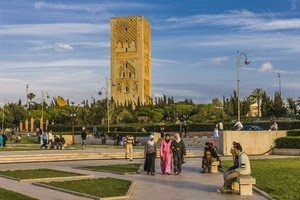The National
Ashley Lane
The Hassan Tower, in the background, which along with the Hassan Mosque is considered Rabat’s most-famous landmark. Getty Images
Why Rabat?
If you’re put off by constant harassment from street vendors or overcrowded streets typically associated with Marrakech, head north to the capital city of Rabat. You’ll find quiet, tree-lined boulevards, relaxing street cafes and enough historical sites to keep you going for days. What the city lacks in bustling nightlife, it makes up for in scenery and culture.
The business hub is making moves to boost its tourism. As part of the Vision 2020 programme, a government effort to make Morocco one of the top 20 tourists destinations in the world, Rabat has seen its fair share of modifications. From the impending launch of The Ritz-Carlton Rabat to the development of the Bouregreg Marina and construction on the minaret at the Hassan Tower, the city is changing.
Flight options are expanding, too, with Etihad launching its first direct route from Abu Dhabi to Rabat last weekend.
A comfortable bed
The Sofitel Jardin des Roses (www.sofitel.com) sits on seven acres of well-groomed Andalusian gardens, and offers a mix of French design and Moroccan art. The hotel is near some of the city’s most popular sites. Rooms cost from 2,200 Moroccan dirhams (Dh815) per night, including taxes.
If you’re in the market for something a bit more traditional, head to the Riad Dar El Kebira (www.darelkebira.com). Located in the medina, in the north part of the city, the guesthouse features Moorish architecture and 10 guest rooms. Rooms cost from €107 (Dh427) per night, including breakfast and taxes.
Find your feet
Many of the top sites are close to one another, making it easy to explore the city in a few days. The walled medina, in the centre, is a wonderful place to roam and shop, without being hassled by vendors. Make sure to pay a visit to the Grande Mosquée, built in the 14th century.
The Hassan Tower and Hassan Mosque sit high above the Bouregreg Marina, home to several construction projects, including La Marina, an Emirati collaboration. The site is considered the city’s most famous landmark. The mosque was destroyed by the Lisbon earthquake of 1755, leaving nothing but ruins. The minaret, which still stands, is 44 metres tall, though original plans were for it to be 60 metres.
Opposite the Hassan Mosque is the Mausoleum of Mohammed V. The building contains the tombs of the Moroccan king and his two sons, King Hassan II and Prince Abdallah. Though the mausoleum’s exterior, Alaouite architecture made mostly of white marble, is notable, the interior is truly astonishing. You’ll find wall-to- wall coloured mosaic tiling and a ceiling constructed from gold leaf and hand-carved cedar wood.
For photos and a chance to quietly take in Rabat’s sights and sounds, head to the Kasbah des Oudaias, perched high on a cliff, overlooking the Atlantic Ocean and Oued Bou Regreg, in the oldest part of the city. While the views are reason enough to visit, it’s the winding alleyways, laden with whitewashed walls and striking blue doors, that impress. Amble down Rue Jamaa, which runs straight through the Kasbah, and visit the city’s oldest mosque, Mosque El-Atiqa, or duck into one of the small shops and art galleries on the way.
Head to the southern part of the city to visit Chellah. The area is the site of the old Roman city Sala Colonia, which was abandoned in AD 1154. It’s overrun with fruit trees and wildflowers, and peppered with must-see attractions, including the Arc de Triomphe, Pool of the Nymph and Islamic complex.
Meet the locals
Stroll along the corniche on the banks of the Oued Bou Regreg, or grab a coffee at Cafe Maure, and sit in the adjacent Andalusian Gardens, in the Kasbah des Oudayas. By 3pm on weekends, both are heaving with families, couples and teenagers enjoying the fresh air. If you find yourself in Agdal in the evening, head over to the unashamedly posh complex of Hay Riad, and join the locals for gelato and a walk down tree-lined streets.
Book a table
Join the swish set at Restaurant Dinarjat, set in a 17th-century, Andalusian-style house in the heart of the medina. The menu is filled with traditional tagines, couscous and brochettes (shish kebabs). The pastilla with chicken, almonds and cinnamon is a must. Round off the meal with a steaming cup of Moroccan tea. Mains cost from 160 dirhams (Dh59).
For French food, try Le Georges (www.facebook.com/bistrotlegeorgesrabat) in Agdal. The menu features sumptuous options such as salmon with fresh herbs and mango tartare, and beef in parsley butter with shallots. Mains cost from 155 dirhams (Dh57).
Shopper’s paradise
For traditional wares, the city’s only souq, in the medina, is the place, selling everything from rugs and leather jackets to fridge magnets and spices. The majority of the stallholders expect customers to haggle.
Don’t miss
The National Archaeology Museum, though small, is well worth the visit. It features the most extensive collection of archaeological artefacts in Morocco. English-speaking tourists should take a guide, however, as most explanations are in Arabic and French.
What to avoid
While the majority of Rabat is safe during the day, pay close attention to your belongings. The streets are quiet later on, so avoid walking alone at night.
Getting there
Etihad (www.etihad.com) flies direct to Rabat from Abu Dhabi, Wednesdays and Fridays, from Dh3,535 per person, including taxes.
alane@thenational.ae
Follow us @TravelNational








